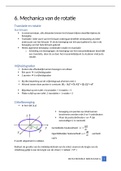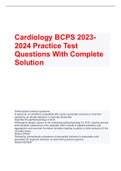Lecture 1: Explaining Health Behaviour
Two parts:
1) The Essence of Health and Medical Psychology
- What is health and medical psychology?
- What is healthy living? What is prevention?
- Why encourage a healthy lifestyle?
2) How can we explain/understand health behaviour?
Where do Health and Medical Psychologists Work?
1) Health care:
● Primary health care (adults, children)
● Private practice
● Organisational health/burn-out prevention
● Secondary health care:
- Mental health organisations
- Pain clinics and rehabilitation centres
● Medical psychology department hospital:
- Pain management
- Oncology and haematology
- Endocrinology
- Cardiology etc.
2) Primary prevention, Policy and Training:
● Municipal health organisations, Public Health Service
● Companies
● Voedingscentrum, Trimbos, Rutgers, etc.
● National health foundations and societies: Hersenstichting, Hartstichting, KWF,
Astma Fonds, etc.
3) Research and Policy
● Universities and research institutes (TNO, Nivel, etc.)
● Local, regional or federal government, Ministries, CBS or CPB, etc.
● Developmental aid organisations
Health and Medical Psychology Topics
- Body and mind interaction
- Coping with chronic diseases
, - Capacity and empowerment
- Stress and disease
- eHealth and self management
- Prevention and health promotion
Lay Perceptions of Health (Blaxter, 1990)
“What does health mean to you?”
● Health as not ill: no symptoms, no visits to doctor
● Health as reserve/resources: strong family, recover quickly
● Health as behaviour: look after myself
● Health as physical fitness and vitality: energetic
● Health as psychological well-being: in harmony, balance, proud, enjoyment,
motivated
● Health as function: to do what I want / have to do
→ Everyone's definition is different, something that's important for you might not be
important for someone else
→ Need to ask person you are working with what is important for them (highly personal)
→ Health has many dimensions (multidimensional)
WHO Definition of Health (1948)
“Health is a state of complete physical, mental, and social well-being and not merely the
absence of disease or infirmity”
● The definition has not been amended since 1948 (still being used), although criticism
has been forwarded…
- “Complete”: who ever feels completely well? Almost no one, but many people
still consider themselves healthy even though definition would imply they are
not (problematic)
Understanding Health and Illness
● Biomedical model
→ Argues that you can only become ill, if there is some type of bodily process
affected
- (Underlying pathology, neural and/or biochemical activity), for example:
- Exposure to contagious “agents”
- Insufficient immune response
● What else predicts health and illness?
- Health behaviours (physical activity, nutrition, sleep, etc.)
- Stress/emotions
- Social relations (support, conflict) can function as a buffer (bad social
relations can cause stress, and therefore reduce health)
,Biopsychosocial Model
● Body and mind in interaction determine health and illness
● Consequences of interplay of biological (genes, pathogens), psychological
(emotions, cognition and behaviour) and social (norms, social cultural background)
factors
● The different systems influence each other continuously
Prevention
Prevention is the main effort of health and medical psychologists…
● Primary prevention: prevention of problem / onset of disease / illness / casualty,
interventions that promote a healthy lifestyle
- Target group = healthy people (don't yet have any health complaints)
● Secondary prevention: tracing illness in an early phase, for early treatment or for
prevention of more serious complaints, includes screening and early treatment
- Target group = (healthy) people with an increased risk for disease
(predisposition for disease)
, ● Tertiary prevention: when illness has already happened, prevention of
complications and worsening of symptoms through optimal care (revalidation and
including self-regulation interventions), involves coping with chronic illness and
having a high quality of life
- Target group = ill people
Does Our Behaviour Influence Our Health?
Cohort studies
● Framingham Heart Study (after WWII)
- 500 people between 30 and 62
- Every 2-6 years participants asked to return and give lots of information about
medical history (physical exams, lab tests)
- Learned that high blood pressure, high cholesterol, unhealthy eating patterns,
smoking, physical inactivity, and unhealthy weight all had a strong relation
with cardiac health
→ to prevent heart problems need to focus on these behaviours
● British Doctor Study (1951)
- 40,000 doctors were followed
- Showed that smoking is strongly related to cancer, cardiovascular disease
and chronic lung disease
Alameda 7 – seven health factors for longevity
Which factors predict health?
1. Exercising
2. Drinking less than five drinks in one sitting
3. Sleeping 7-8 hours a night
4. Not smoking
5. Maintaining desirable weight for height
6. Avoid snacks
7. Eating breakfast
Types of health behaviors
● Matarazzo (1984) makes a distinction between:
- Behavioral pathogens (health risk behaviors): smoking, alcohol and drug
abuse, sharing needles, multiple sex partners, unsafe sex, drink driving, no
ear protection, etc.
- Behavioural immunogens (health protective behaviours): physical activity,
healthy nutrition (e.g., low in fat, sugar and salt, vegetables and fruit), sun
protection, bicycle helmet, vaccinations, medication, etc.
Why encourage a healthy lifestyle?




